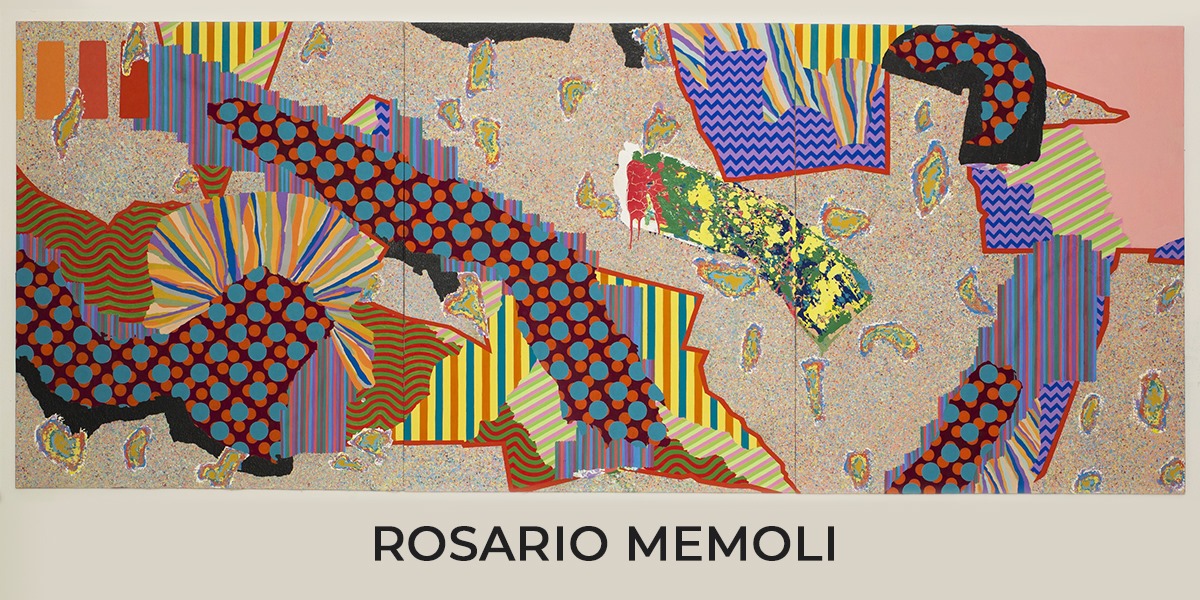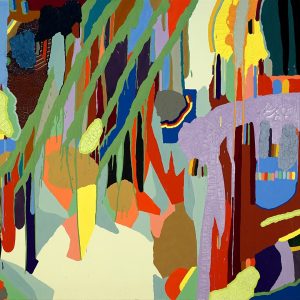Rosario Memoli, the artist who invites you to lose yourself in shapes and colours

 Rosario Memoli is an eclectic artist: he is a painter, but he is also a sculptor, a videoperformer and a singer. What is art for him? It is a continuous visual quest, where colours, fabrics and shapes are always changing. Also the imagination is always on the move. We asked Rosario what art stands for him, exploring his multifaceted world.
Rosario Memoli is an eclectic artist: he is a painter, but he is also a sculptor, a videoperformer and a singer. What is art for him? It is a continuous visual quest, where colours, fabrics and shapes are always changing. Also the imagination is always on the move. We asked Rosario what art stands for him, exploring his multifaceted world.
What strikes you at first glance is the absolute energy that comes out of each work. Because Rosario’s works cannot just be described as ‘paintings’, ‘sculptures’ or ‘installations’. Each of these works is an authentic sensory experience, where colours and shapes take on different identities each time.
Rosario Memoli was born in Salerno in July 1979, and he still lives in his hometown. His career has been a rollercoaster of successes. Firstly, Rosario graduated in painting from the Academy of Fine Arts in Florence. Then he took a master’s degree in Event Cultural Management at the Suor Orsola Benincasa Institute. His life is a countless exhibitions and shows, around Italy and beyond. From Pistoia to Rome, from Freiburg in Switzerland to the sale of his paintings for the American market.
Rosario has therefore distinguished himself in the various fields in which he excels. For example, his paintings were included in Paola Bizzarri’s sets for the Italian TV series Braccialetti rossi; he was the set designer for Il Poeta e la Città in Salerno, a series of meetings and readings about the poetry of Alfonso Gatto; he was also an extraordinary video performer for Il Sigaro di fuoco, a musical reading about Alfonso Gatto’s poems for children.
Here, then, is a conversation with an artist who was also a very welcome guest at one of our events.
First of all, why do you choose the abstract art?
Since I was a child, I have had a talent for drawing. But I have also been interested in comics, illustration and graphics over the years. When I began painting, and with a growing passion for art history, especially 20th century art, I discovered a new expressive dimension. The canvas often became enormous and sometimes not enough. So I had to introduce the ‘real-life objects’, which created surprising languages by dialoguing in a new way. Painters’ materials (and others) could mean anything in this infinite creative possibility, if they sustained a serious and effective approach. That’s why I started experimenting, and immediately understood that this was a boundless field. I went towards what satisfied me and I was in harmony with my path.
Your paintings are very special, as is your use of different materials. Where does the right idea for the painting come from, and how does it find the most suitable material on which to express itself?
The idea is to use both colours designed for art and those designed for other sectors such as construction (such as wall painting), because they have very different consistencies and gradations and allow for different processes. This is essentially what you find on my canvases. I don’t think of a particular painting, and I never design a work. I choose a surface (usually a canvas), then I arrange the materials and tools that interest me (acrylics, wall paint, brushes and spatulas). Finally, I start painting, almost as if it were the first time.
I am left with the desire to experiment and to structure each image differently. What I love is to combine the elements of my painting and then maybe discover others. I often work on sculptures, sewing and drawings at the same time, with paper, wood and textiles. However, I always try to give each work an autonomous dimension. So I start with a general idea, which then guides my work, but it is not a real formula.
How have you shared your creativity with others over the last few months, especially during this period when it has been impossible to participate in exhibitions and shows?
I have taken advantage of this period to renew my website. Social networks have also been useful tools to reawaken interest in my work among a circle of enthusiasts close to me; I will see the results soon. Now we need targeted work to go further. I also had the chance to be part as an exhibitor in one of the few exhibitions held in the area: a tribute to Ugo Marano hosted in the evocative Hermitage of the Holy Spirit in Pellezzano.
In addition to art, we know that your great passion is music. We know you have a band (Provolone records), and back in 2007 our association organised the event in which you participated. What would you like Nziria to do or (re)do for music?
Well, the band is now called The Provincials. But in the past, that slightly irreverent name was a moniker for the first few years, in order to give it a ramshackle and unprofessional appeal. This is reflected in how we chose Provolone Records as the title of our first release on the Disco Futurissimo label. The tracks were composed and recorded entirely by me with a cassette recorder, a classical guitar and a computer. They have a low-fi sound that I still find interesting. As for Nziria Zoo I have very fond memories of it. I was greeted with the music of the Godfather because I had lingered on stage for one last piece, even though the time was counted. I still apologise for this years later, but it was great fun! Rules aside, there was an atmosphere of real friendship.
I think events like that are very useful to share ideas.I remember an interview of Bowie’s where he said that people went to concerts to exchange information, and I think that is still true. it is cultural and emotional knowledge that comes out under certain conditions, which a concert certainly stimulates. A new Nziria festival would be desirable!
Chiara Grasso







